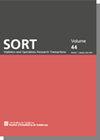估计区域社会会计矩阵以分析农村发展
IF 1.2
4区 数学
Q4 OPERATIONS RESEARCH & MANAGEMENT SCIENCE
Sort-Statistics and Operations Research Transactions
Pub Date : 2017-12-19
DOI:10.2436/20.8080.02.62
引用次数: 3
摘要
本文有两个互补的目标:一方面,它介绍了(区域)社会会计矩阵估计的欧元方法。这一方法被欧共体统计局广泛用于估计缺少的国家供应、使用和投入产出表,但以前从未在社会核算矩阵或区域统计和/或区域影响分析的范围内使用过。另一方面,这项工作讨论了产生非基于调查的区域社会核算矩阵的可能性,这些矩阵最终可能允许用户进行诸如农村发展政策等影响分析。分析是基于集群对12个选定的欧洲地区进行的。本文章由计算机程序翻译,如有差异,请以英文原文为准。
Estimating regional social accounting matrices to analyse rural development
This paper has two complementary objectives: on the one hand, it introduces the EURO method for the estimation of (regional) Social Accounting Matrices. This method is widely used by Eurostat for the estimation of missing national Supply, Use and Input-output tables but it has not been used before within the context of social accounting matrices or of regional statistics and/or regional impact analyses. On the other hand, this work discusses the possibility of producing non-survey based regional Social Accounting Matrices that may eventually allow the user to carry out impact analyses such as those of rural development policies, among others. The analysis is carried out for 12 selected European regions based on clusters.
求助全文
通过发布文献求助,成功后即可免费获取论文全文。
去求助
来源期刊

Sort-Statistics and Operations Research Transactions
管理科学-统计学与概率论
CiteScore
3.10
自引率
0.00%
发文量
0
审稿时长
>12 weeks
期刊介绍:
SORT (Statistics and Operations Research Transactions) —formerly Qüestiió— is an international journal launched in 2003. It is published twice-yearly, in English, by the Statistical Institute of Catalonia (Idescat). The journal is co-edited by the Universitat Politècnica de Catalunya, Universitat de Barcelona, Universitat Autonòma de Barcelona, Universitat de Girona, Universitat Pompeu Fabra i Universitat de Lleida, with the co-operation of the Spanish Section of the International Biometric Society and the Catalan Statistical Society. SORT promotes the publication of original articles of a methodological or applied nature or motivated by an applied problem in statistics, operations research, official statistics or biometrics as well as book reviews. We encourage authors to include an example of a real data set in their manuscripts.
 求助内容:
求助内容: 应助结果提醒方式:
应助结果提醒方式:


